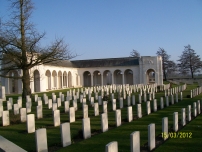| First Name: | William Harold | Last Name: | NOYCE | |
|---|---|---|---|---|
| Date of Death: | 09/05/1915 | Lived/Born In: | Peckham | |
| Rank: | Private | Unit: | Welsh2 | |
| Memorial Site: | 1. Peckham, All Saints 2. Le Touret Memorial, France | |||
Current Information:Age-22 26, Shard Road, Peckham Aubers Ridge On 9 May 1915 the British attacked north at Arras as part of the British contribution to the Second Battle of Artois, a Franco-British offensive. Their objective was the capture of Aubers Ridge but it turned into an unmitigated disaster. The German defences had been much improved since the Battle of Neuve Chapelle in March and the British artillery was in a parlous condition and failed to destroy the German defences during the short and insufficient 40 minute bombardment that preceded the attack. Extra artillery had been requested but further to the north, the Second Battle of Ypres was being fought on a ferocious scale and none was forthcoming. The few initial gains could not be held and by the evening of 9 May, all the British forces were back where they started, except of course the dead who littered the battlefield. There were 11,000 casualties for the British Army. 1st Division attacked in front of Richbourg-l’Avoué. 2nd Welsh and 2nd Royal Munster Fusiliers led the attack on 3 Brigade’s front but heavy machine gun fire from 22 German machine guns hit the leading units and only a handful of them reached the German front line where they took what cover they could until some were able to make it back to their own lines. The following is part of an account given by Lieutenant B Cripps, who was awarded the MC for bringing in wounded during this action;- “On the Welch front there was a distance of about 150yds between the opposing lines. About 20yds in front of our parapet was an old trench half full of water; about 25yds further on ran a stream, some 3yds across and 2-4ft deep with banks about 2ft above water level; then about 80yds further came the German wire, behind which the raised enemy parapet was clearly visible. During the night the R.E’s had placed duckboard bridges, made of new unpainted wood, across the stream…...Field guns very erratic .many casualties from short rounds. Dawn-fine sunny morning. …… Few shells appeared to be going anywhere near the German wire or parapet and the tops of the bayonets of the Germans, crouching behind their parapet, could be clearly seen. As the first wave mounted the parapet it was met with a hail of bullets, and many men fell back, dead or wounded, into the trench. At the end of a minute I blew my whistle and the second wave went over the top. There were no troops visible-every man was down and there were heaps of dead and wounded by every bridge. I ran between the bridges and reached the stream, by which time few of us were left standing. What remained of us got into the water with the Germans standing up in full view firing at us. Any movement drew fire; many of the wounded were drowned. No other troops appeared and the firing died down. I was the only officer in B Company left unwounded…A message in a tin was thrown into the stream to say that the attack would be renewed at 7am and that the remnants of the leading companies were to join in this attack. Actually it never materialised as the reserve companies were shot to pieces in getting to the front trench (So heavy was the fire that 3 + 76 of A Coy were hit before reaching the Brit front line.) Collecting about 30 wounded and a few unwounded men I set to work to dig a shallow communication trench back to our original line. This was completed by midday and crawling along it we all got back safely to our original trench. The survivors had been in the water since 5.30am and suffered greatly from the cold.” |
||||
| « Back to Search Results | ||||
| If you think any of the information shown here is incorrect, Click Here to submit your amends and comments | ||||




